Welcome to a fragrant journey into the world of Arabic flowers! Just as poetry and art flourish in the Arab world, so too does a rich appreciation for the beauty and symbolism of the natural world, particularly Arab flowers. Learning the names of these blossoms not only expands your Arabic vocabulary but also offers a glimpse into the cultural significance and aesthetic sensibilities of the Middle East. Join us as we explore some of the most beautiful and evocative Middle Eastern flowers and their names in Arabic.
The Language of Blooms: Common Arabic Flowers
Let’s begin with some of the most common and beloved Arabic flowers, along with their names in Arabic:
- Rose – وَرْد (Ward) . The quintessential flower of love and beauty, the rose is cherished throughout the Arab world and features prominently in poetry and song.
- Jasmine – يَاسَمِين (Yāsamīn) . With its intoxicating fragrance, jasmine is a popular ornamental flower and symbolizes purity and sweetness.
- Arabian Jasmine / Sambac Jasmine – زَهْرَة الْفُلّ (Zahrat al-full) . Another highly fragrant jasmine variety, often associated with romance and used in perfumes and traditional adornments.
- Carnation / Clove Pink – قَرَنْفُل (Qaranful) . These ruffled flowers come in various colors and symbolize fascination and distinction.
- Lavender – زَهْرَة الْخُزامَى (Zahrat al-khuzāmā) . Known for its soothing scent and beautiful purple hues, lavender is used in perfumes, aromatherapy, and traditional medicine.
- Violet – بَنَفْسَج (Banafsaj) . These delicate flowers, often purple but also found in other colors, symbolize modesty and virtue.
- Narcissus / Daffodil – زَهْرَة النَّرْجِس (Zahrat an-narjis) . These cheerful spring blooms symbolize rebirth and new beginnings.
- Daisy / Chamomile – أَقْحُوَان (ʾAqḥuwān) . Simple and charming, daisies represent innocence and purity. Chamomile is also known for its medicinal properties.
- Iris – زَهْرَة السُّوسَن (Zahrat as-sūsan) . With their elegant and intricate petals, irises symbolize eloquence and wisdom.
- Sunflower – زَهْرَة عَبَّاد الشَّمْس (Zahrat ʿabbād ash-shams) . These bright and sunny flowers symbolize adoration and longevity.
Regional Blooms: Middle Eastern Flowers with Local Flair
The diverse climates and landscapes of the Middle East are home to a variety of unique Middle Eastern flowers that hold regional significance:
- Jujube Flower / Christ’s Thorn Jujube Flower – زَهْرَة السِّدْر (Zahrat as-sidr) . The flowers of the Sidr tree are small and fragrant, and the tree itself holds cultural and medicinal importance in many Arab regions. Its honey is also highly prized.
- Oleander – زَهْرَة الدِّفْلَى (Zahrat ad-diflā) . While beautiful with their clusters of pink, white, or red flowers, oleanders are toxic and serve as a reminder of nature’s duality.
- Anemone / Poppy Anemone – زَهْرَة شَقَائِق النُّعْمَان (Zahrat shaqāʾiq an-nuʿmān) . These vibrant wildflowers, particularly the red variety, are often seen in the spring and can evoke feelings of beauty and fragility.
- Henna Flower – زَهْرَة الْحَنَّاء (Zahrat al-ḥinnā) . Known for its fragrant blossoms, the henna plant is also famous for the dye derived from its leaves, used for traditional body art in many Arab cultures.
- Cactus Flower – زَهْرَة الصَّبَّار (Zahrat aṣ-ṣabbār) . The resilient cactus produces surprisingly beautiful and often short-lived flowers, symbolizing endurance and strength in harsh environments.
The Language of Flowers: Symbolism in Arab Culture
Like many cultures around the world, Arab societies often associate specific meanings with Arabic flowers:
- Roses (وَرْد) are widely seen as symbols of love, passion, and beauty, often exchanged between romantic partners and used in celebrations.
- Jasmine (يَاسَمِين) represents purity, love, and sensuality, and its fragrance is highly valued.
- Orange blossoms (زَهْرَة الْبُرْتُقَال – Zahrat al-burtuqāl) symbolize purity, innocence, and fertility, often used in wedding decorations.
- The specific color of a flower can also carry meaning. For example, red roses signify deep love, while white roses can represent purity or sympathy.
Understanding this floral symbolism adds another layer to your appreciation of Arab culture.
Expanding Your Vocabulary: More Beautiful Blooms
Here are a few more Arabic flowers to enrich your vocabulary:
- Lily – زنبق (Zanbaq)
- Orchid – أوركيد (ʾŪrkīd)
- Tulip – زهرة التيوليب (Zahrat at-tyūlīb)
- Wild Carnation – قرنفل بري (Qaranful barrī)
- Primrose – زهرة الربيع (Zahrat ar-rabīʿ)
Learning the names of these Arabic flowers is a delightful way to connect with the beauty of the natural world as expressed in the Arabic language.
To further expand your Arabic vocabulary and immerse yourself in the rich tapestry of Arab culture, we invite you to visit www.kaleela.com. Our platform offers engaging lessons and cultural insights to enhance your learning experience. Download the Kaleela Arabic learning app today and watch your language skills blossom!



